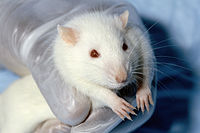Animal Testing
Immoral, illogical, arrogant, and unsafe. Natural ingredients have usually not been tested on animals: stick with natural products, for your health and for our animal neighbors’ health as well.
Animal testing, also known as animal experimentation, animal research, and in vivo testing, is the use of non-human animals in experiments that seek to control the variables that affect the behavior or biological system under study. This approach can be contrasted with field studies in which animals are observed in their natural environments or habitats. Experimental research with animals is usually conducted in universities, medical schools, pharmaceutical companies, defense establishments, and commercial facilities that provide animal-testing services to the industry. The focus of animal testing varies on a continuum from pure research, focusing on developing fundamental knowledge of an organism, to applied research, which may focus on answering some questions of great practical importance, such as finding a cure for a disease. Examples of applied research include testing disease treatments, breeding, defense research, and toxicology, including cosmetics testing. In education, animal testing is sometimes a component of biology or psychology courses. The practice is regulated to varying degrees in different countries.
 | |
| Description | Around 50–100 million vertebrate animals are used in experiments annually. |
|---|---|
| Subjects | Animal testing, science, medicine, animal welfare, animal rights, ethics |
It was estimated in 2010 that the annual use of vertebrate animals—from zebrafish to non-human primates—ranges from tens to over 100 million. In the European Union, vertebrate species represent 93% of animals used in research, and 11.5 million animals were used there in 2011. By one estimate, the number of mice and rats used in the United States alone in 2001 was 80 million. In 2013 it was reported that mammals (mice and rats), fish, amphibians, and reptiles together accounted for over 85% of research animals.








